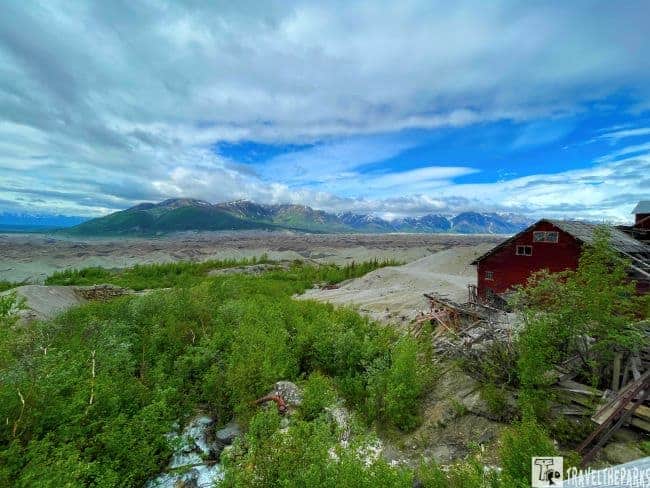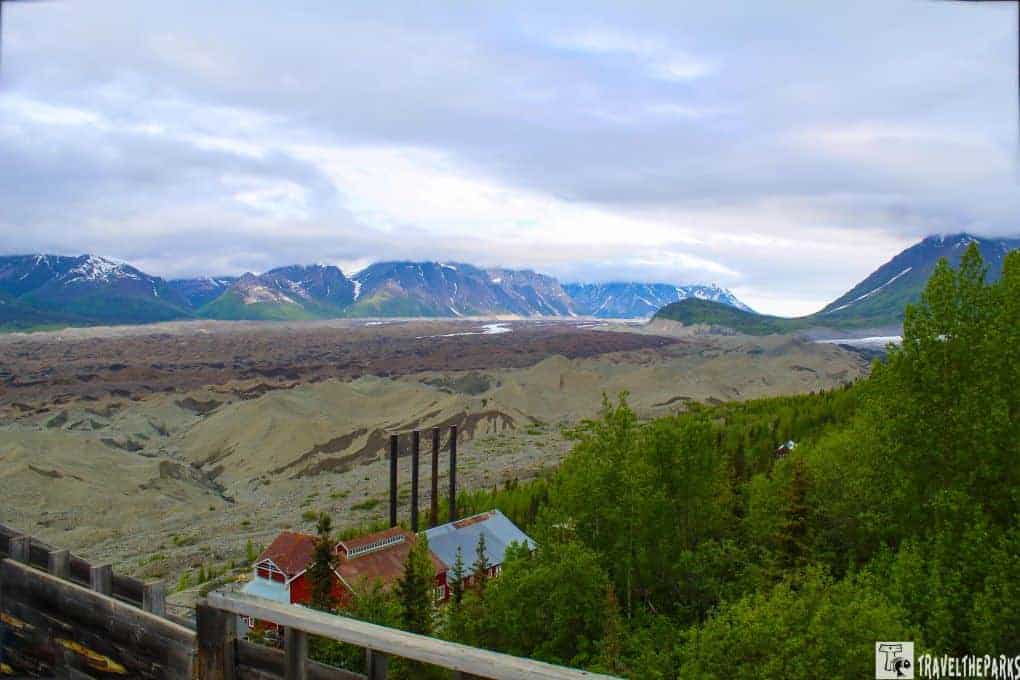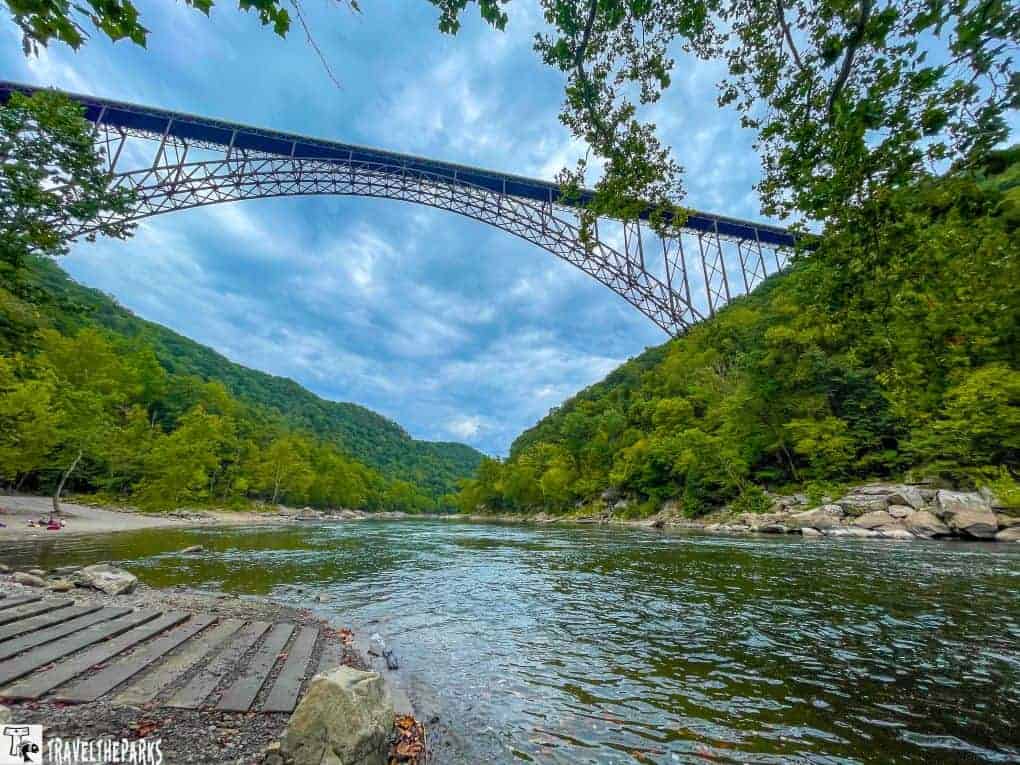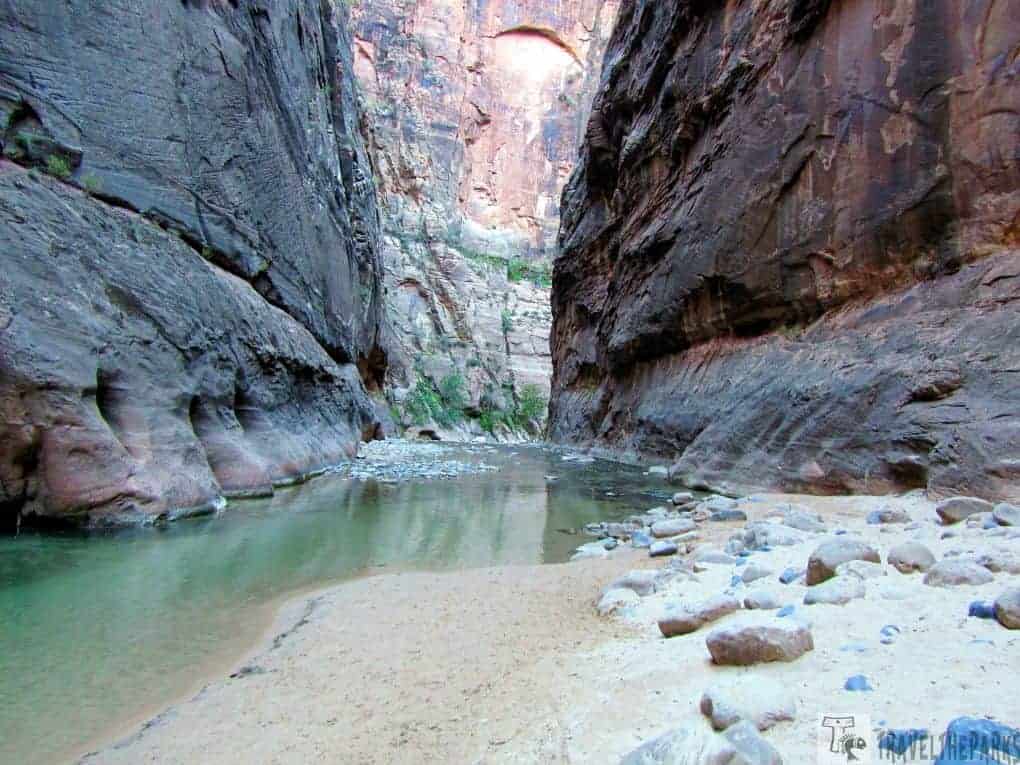In the heart of the Alaskan wilderness, nestled amidst the awe-inspiring Wrangell Mountains, lies the forgotten ghost town of Kennecott. Once a thriving copper mining town, Kennecott Mines National Historic Landmark now stands as an enchanting relic frozen in time. Join us on our journey as we uncovered its hidden secrets. On an early June morning, it was easy to immerse ourselves in the beauty of this abandoned gem. On a guided tour, we delved into the fascinating history of the Kennecott Mine. Our guide helped us to unearth this place’s timeless charm. For many, the Kennecott Mine remains an enduring symbol of Alaska’s mining heritage and a window into the challenges and triumphs of those who shaped the region’s history.

Walking through the empty streets, it was like it carried us into an extraordinary era. The weathered buildings, with their faded facades and cracked windows, whispered tales of a bustling community that once thrived in this remote corner of Alaska. The iconic red Mill Building, once the heartbeat of the town, now stands as a stoic sentinel, its walls echoing the sounds of machinery and the shouts of workers long gone. If these walls could take what they would tell us.
This post may contain affiliate links, meaning if you purchase something through one of these links, we may earn a small commission at no extra cost to you! Read the full disclosure policy here.

Table of Contents
Getting to the Kennecott Mine
The first decision you’ll need to make is how you’ll travel to Kennecott. Anchorage is the most common starting point for travelers heading to Kennicott. From Anchorage, you can choose to rent a car and travel the Glenn Highwa, Richardson Highway or take a smaller regional flight to the town of Chitina. From Chitna, because of its remote location, there are a few options to consider:
First choice is to self drive. The Kennecott Mine can be reached by road trip if you prefer that flexibility. The McCarthy Road is the primary route to Kennecott. This gravel road runs for 60 miles from the town of Chitina, the entrance to Wrangell St. Elias National Park. It is important to keep in mind that this road can be rough and demanding. Check the road conditions before you start your journey. The meeting time for the Kennecott Mine tour was 9:30 am, so we started our journey at 4 AM from the Pippen Lakeside B&B Cabin.

Use Shuttle Services to Drive the McCarthy Road
Another option is to take advantage of shuttle services that operate between Chitina and Kennecott. Designed specifically for rugged road conditions, these shuttles can provide you an alternative way to reach the mine. They can usually make bookings in advance for round-trip transportation. On our first trip, we used Kennicott Shuttle.

Flightseeing Tour into McCarthy
The quickest option ($$$) is with Wrangell Mountain Air Service, you can enjoy a flightseeing tour that is truly extraordinary. The flights between Chitina and McCarthy are scheduled every day. During these flights, you will see the spectacular landscapes of Wrangell-St. Elias National Park. During these tours, you can see glaciers, mountains, and the Kennecott Mine from the air.
No matter how you choose to get there, your tour begins at the end of the road. At the end of the road, we parked our vehicle in a designated parking area. Glacier View Campground ($5) is the closest to the footbridge. To access the Kennecott Mine, you’ll need to cross a footbridge over the Kennicott River. Once across, there are shuttles available or you can walk the short 1/2-mile to McCarthy. We used the free Copper Shuttle. The Blackburn Heritage Shuttle is $5 one-way. These shuttles take you 5 mile past McCarthy up to Kennecott mine.

So is it Kennecott or Kennicott?
Kennicott Glacier inspired the name of the mining company. A slight spelling variation (adding an extra “e” in Kennecott) because of a clerical error that was never corrected. Today, it still results in spelling debates. The town was spelled with a “y” by the company’s founder, Stephen Birch.

The Back Story: The Rise of Kennecott
It is a fascinating tale of human endeavor, industrial ambition, and the harsh realities of Alaska’s remote backcountry. The town was established in the early 20th century and became famous for its massive copper deposits.
The tale begins in 1900, when two prospectors named Clarence Warner and “Tarantula” Jack Smith were exploring the region for valuable minerals. Looking up from the Kennicott glacier, they sighted upon a large outcrop of greenish rocks on the mountain ridge. Recognizing the potential significance of the find, they staked their claims and soon spread the word about their discovery of the 70% pure chalcocite. This revelation set in motion a chain of events that would shape the destiny of the region and leave behind a lasting legacy.
The news of the copper discovery reached the ears of Stephen Birch, a mining engineer and promoter. Birch saw the immense potential of the copper deposit and formed the Alaska Syndicate, a group of investors, to acquire the claims and develop the mining operation. The mine was named after the Kennicott Glacier but was spelled incorrectly. Read the entire story here.

Journey into the Past: An Industrial Marvel
The quest to develop the mine was no easy feat. This location has raised many challenges. Specifically, the lack of infrastructure, extreme weather. In addition, the daunting task of moving equipment and supplies to the remote site. However, the sheer richness of the copper deposits drove the ambitious project forward.
The construction of the Kennecott Mine and the adjacent town of Kennecott began in 1907. Engineers and workers flocked to the area,. Many surviving the harsh Alaskan wilderness in their pursuit of copper. The mine quickly grew into a bustling community, complete with schools, hospitals, stores, and recreational facilities. At its peak, Kennecott boasted a population of over 500 people.

The mining operations at Kennecott were remarkable in their scale and innovation. The mine used state-of-the-art technologies for the time. This incorporated an aerial tramway system that carried copper ore from the mines to the mill for processing. The mill itself was a marvel of engineering, capable of processing vast loads of ore to extract the valuable copper.
For over three decades, the Kennecott Mine operated successfully, adding significantly to the economy of the region. However, as the years passed, the ore deposits declined, and the costs of extraction became increasingly steep. Marking the end of an era, the mine was closed in 1938.

The Downturn Neglected, Abandonment and Preservation
Over time, people gradually left the once-thriving town of Kennecott. Nature began its slow process of reclaiming the structures. Gradually, the elements have taken over the buildings, machinery, and remains of the mining operations. Over time, creating a hauntingly beautiful ghost town in the heart of Wrangell St. Elias National Park.

In the 1980s, recognizing the historical and cultural significance of Kennecott, the National Park Service took over the preservation and management of the site. Today, the Kennecott Mines National Historic Landmark stands as a testament to the industrious spirit of the former miners and the harsh truths they faced in their pursuit of copper. On the Kennecott Mill Town Tour , you see the efforts to safeguard and protect the historic site.

Best Things to do in Kennecott Alaska
Exploring Kennecott, Alaska, is an adventure. Whether you’re drawn to the history of the past, or simply seek outdoor adventure, Kennecott has something to offer. It’s an experience that will leave you with lasting memories and a deeper appreciation for the resilience of those who lived and worked in this remarkable place. Step into the present as we guide you through our experience of visiting the Kennecott Mine.

If time permits these are a few of the stops to make visiting Kennecott.
- Taking a guided tour or venture on your own to immerse yourself in the rich history of Kennecott. We highly recommend a guided tour to discover the engineering feats that allowed the mine to operate in this challenging environment.
- McCarthy-Kennicott Historical Museum: It is housed in the former copper company store. Here we caught a glimpse into the town’s history and the lives of the people who lived and worked there.
- Wrangell – St. Elias National Park Visitor Center: The exhibits help you learn about the lives of the miners and their families, their struggles, and successes, as you explore the artifacts that bring their stories to life.

Root Glacier: A Glacial Adventure
While Kennecott’s history is captivating, the surrounding area is equally breathtaking. Be sure to step outside and embrace the vast wilderness that envelopes this ghost town. The soaring peaks, shimmering glaciers, and meandering rivers offer a majestic backdrop for exploration. We included a leisurely hike out on the Root Glacier Trail. Hikers can finish the relatively flat trail in a few hours. At the end of the trail, you can walk on the glacier. We also had amazing views of the captivating ice caves and jaw-dropping crevasses. Not having crampons, we only ventured a short distance on the glacier. Before leaving the trail, we paused to soak in the remarkable vistas that stretched as far as the eye could see. Mount Blackburn was barely visible through the low-hanging clouds.

For those who wish to explore the Root Glacier’s icy realm with added safety and knowledge, guided glacier tours provide an excellent option.

The Kennecott Mine Tour with St. Elias Alpine Guides
Visitors to Kennecott can explore the well-preserved building, taking either a self-guided or guided tours with St. Elias Alpine Guides. Only on the guided tours can you enter the 14-story mill process building. You will learn in depth about the history and engineering feats of the mine. Our impressive guide, Michael, delighted us with entertaining stories of the people who once called this place home. Tours are available to reserve at 9:30 a.m., 1:30 p.m., and 3:30 p.m. They generally last around 2 hours.
NOTE: As you wander through Kennecott Copper Mill Town, don’t forget to bring your camera to capture the magic of this abandoned time capsule.

Catching a Glimpse Into a Moment in Time in the Abandoned Kennecott Mine
Our tour began with a steady 150 foot elevation climb to the 11th floor of the Concentration Mill building. The iconic red Mill Building is a centerpiece of the Kennecott Mine tour. At the top along the tramway lines, I could imagine the carts transporting valuable copper ore. Each day, the five Kennecott mines transported 1,200 tons of ore to this concentration mill. We marveled at this feat of engineering as we stepped inside the building.

Inside, you are witnessing the remnants of a bygone era. First, we all had to don hardhats. The Kennecott copper mine concentration building, also known as the mill building, is a multi-level structure where the copper ore goes through various stages of processing and separation using gravity.

Our guide delve into the techniques and state-of-the-art technologies employed to extract copper from the depths of the earth. Moving through the multiple levels, we saw the complex machinery used to crush, grind, and separate the copper ore. We discovered the impressive structures that allowed the mine to operate efficiently.

Kennecott Mine Concentration Building Tour
At the Kennecott Mine concentration building, various techniques are used to separate copper ore. Copper ore typically contains a mixture of copper minerals, gangue minerals (unwanted minerals), and other impurities. The goal of the separation process is to extract the copper minerals and remove the gangue minerals and impurities.

The first step on the uppermost floor is crushing and grinding. The copper ore is first crushed into smaller pieces and then ground into a fine powder. This increases the surface area of the ore, allowing for better interaction with the chemicals used in the subsequent steps.

Typically, people use the Plat-O-Slime table for separating and concentrating heavy minerals like gold, silver, and other precious metals, as well as industrial minerals. This table consists of a flat surface that is inclined and mounted on a supporting structure. The table has a riffled deck covering its surface, which helps create a turbulent flow of water.
As the feed material spreads across the table, the heavy particles with high specific gravity settle into the riffles, while the lighter particles are carried away by the water flow. The table’s shaking motion, usually generated by an eccentric drive or other mechanical means, helps to enhance the separation process.

The Machine and Electrical Shop of Kennecott
The Machine and Electrical Shops once hummed with the sounds of industry and craftsmanship. Each served as a hub for the maintenance, repair, and fabrication of essential machinery and electrical equipment. Skilled craftsmen, machinists, and electricians painstakingly worked within its walls to keep the mining operations running smoothly. They were adept at troubleshooting complex machinery, fabricating custom parts, and maintaining the sophisticated electrical systems that powered the mine.

A Testament to Innovation: Ammonia Leaching Plant
One of the remarkable features of the historic Kennecott Mine is its Ammonia Leaching Plant, a pioneering facility that revolutionized the extraction of copper ore during its operation. The Ammonia Leaching Plant played a crucial role in the mining operations at Kennecott, employing an innovative process that maximized copper recovery and reduced environmental impact.

Flotation: A last Ditch Effort to Collect the Copper
Indeed, they used the flotation process at the Kennecott Mines to separate copper minerals from the ore. Collectors selectively attached to the copper minerals, making them hydrophobic, while frothers created a stable froth layer.the copper minerals, making them hydrophobic, while frothers created a stable froth layer.
In flotation cells or tanks filled with water, they introduced the conditioned ore slurry. Injecting air or a mixture of air and oxygen created frothing into the cells. The hydrophobic copper minerals attached to the air bubbles and rose to the top of the flotation cells as froth, while the gangue minerals and impurities remained in the water. The collected froth concentrate underwent thickening and filtration processes to remove excess water. To transport the concentrate to Cordova, the concentrate was dried, sacked, and stacked on rail cars. Using this additional process, the mine was able to recover/purify copper to 97-99% purity.

Halls of History: The Bunkhouses
Venturing deeper into the town, we discovered the Bunkhouse, a place where the miners found solace and camaraderie after long days in the mines. The Bunkhouses gave us a unique perspective on the living conditions that existed in this remote mining community. There were three bunkhouses: National Creek Bunkhouse (1908), the east bunkhouse (1910) and the west bunkhouse (1917). The bunkhouses featured rows of individual rooms, each equipped with basic comforts such as beds, storage, and heating.

It is important to remember that behind the imposing industrial façade lies a tapestry of human stories. Our guide, Michael’s stories, introduced us to the miners and their families who braved the harsh Alaskan wilderness in pursuit of a better future. We heard the tales of the indomitable spirit that defined life in this remote mining town.

A Glimpse into the Varied Housing
Worker cottages were another type of housing in Kennecott, typically provided to skilled workers with families. These cottages offered a step up from the miners’ quarters, featuring more spacious accommodations and amenities. They served as homes for professionals such as engineers, office staff, and other skilled workers who played a crucial role in the operation and management of the mining company.

In stark contrast to the cottages, Silk Stocking Row was an exclusive enclave reserved for the elite members of the mining company and their families. This row of elegant houses boasted more spacious and luxurious accommodations, earning its name from the higher social status and affluence of its residents.

The Power Plant (1911)
The Power Plant served as the heart of the town, generating the electricity needed to operate the machinery, lighting, and other essential systems in Kennecott. While exploring the interior, we learn about the fascinating power generation methods used during the mine’s operation. Two diesel generators, a Westinghouse steam turbine, and a Pelton waterwheel were used to heat the steam. I could almost hear the constant hum of machinery, the hiss of steam required to power the mining operations. “Utilidors” carried steam and electric power to distant buildings and homes. Utilidors were built under wooden walkways that kept them snow- and ice-free.

Preserving Knowledge: The Schoolhouse
I couldn’t wait to visit the Schoolhouse. As a teacher, I wanted to see the educational facilities available to the children of the miners. Exploring the classrooms, I could definitely imagine the lessons that took place in this remote wilderness. It made me gain insights into the educational system of that era while appreciating our current system. The Schoolhouse, now empty and still, evokes memories of laughter and learning that once filled its halls.

Self Sustaining: Kennecott Dairy Barn
The presence of the Dairy Barn highlights the self-sufficiency that Kennecott strived to achieve. The ability to produce their own dairy products reduced the reliance on distant supply chains and ensured a fresh and reliable source of nutrition for the community. It housed cows, which were carefully tended to by skilled workers, ensuring a steady supply of fresh milk, butter, and cheese for Kennecott residents.

The Importance of National Creek when Exploring Kennecott Alaska
This pristine waterway holds immense importance, both ecologically and historically, contributing to the unique character and significance of the Kennecott area. The creek originates from glaciers in the surrounding Wrangell Mountains, carrying the meltwater and sediment down its course. Water from the creek was diverted to power the massive machines and equipment used in the mining process. The energy harnessed from the creek’s flow contributed to the extraction and processing of copper, fueling the growth and prosperity of the mining town.
National Creek served as a vital water source for the Kennecott Mine. Water is essential for various mining operations, including ore processing, power generation, and human consumption. National Creek provided a consistent and reliable water supply to support the mining activities at Kennecott.

The General Store and U.S. Post Office
These two buildings were vital hubs of community life. They served as gathering places, sources of supplies, and connections to the outside world during the heyday of the Kennecott copper mining operations.

We stepped into the General Store, admiring the preserved shelves, displays, and remnants of the store, which supplied the community with essential goods and provisions. From groceries and clothing to tools and household items, the General Store stocked an impressive variety of supplies. It was like stepping back in time.
Connected to the General Store is the Post Office. It was a lifeline of communication for residents, miners, and their families. Letters, packages, and news from loved ones far away would arrive at the Post Office. It brought a sense of connection, keeping the community informed about events beyond the Alaskan wilderness.


A Place of Gathering at Kennecott Mine: The Recreation Hall
From holiday parties and festive gatherings to town meetings and special occasions, the building accommodated a range of events that brought the community together. In a town isolated by its remote location, the Recreation Hall offered a much-needed respite from the rigors of mining. Inside its walls, one could find billiards tables, dart boards, board games, and other forms of amusement. The stage often hosted plays, concerts, and talent shows, showcasing the artistic talents of the community. There were many indoor sports, such as basketball, volleyball, and bowling provided opportunities for friendly competition and physical fitness.

Preserving History of this Ghost Town: Other Structures
Each building holds a story, a glimpse into the lives of those who called Kennecott home. besides the main buildings, there are several other structures you can explore on your own after the tour. Each building shows a different perspective on the daily life and community dynamics of the mining town.
- General Management Office (GMO)-This well-preserved structure served as the hub of decision-making and coordination, overseeing the day-to-day operations of the mining company and ensuring the smooth functioning of the entire community. Exhibits detail the day-to-day operations of the mine.
- The Refrigeration Plant: this plant played a crucial role in preserving perishable goods and providing a reliable source of refrigeration. Currently restored.
- Hospital and Medical Facilities: The healthcare needs of the Kennecott community were met by a hospital and associated medical facilities. These buildings were essential for the well-being of the residents, providing medical services, emergency care, and a place to heal. Today, they serve as reminders of the importance placed on the health and welfare of the town’s inhabitants.
- Sawmill & Carpentry Shop (1908): This produced the lumber to build and maintain the structures that defined Kennecott. All that remains is the rubble of the collapsed building.
- The Assay Office: This unassuming yet essential structure played a vital role in the evaluation and determination of the quality and value of the precious metals extracted from the nearby mines. Assayers played a pivotal role in ensuring fair compensation for the miners and establishing the foundation for the town’s economic success. The flood turned the building into rubble.

The Historic Train Depot of Kennicott Town, Alaska
The Train Depot served as the gateway to Kennecott. It was the terminus for the Copper River & Northwestern Railroad, furnishing a link to the outside world. It was the arrival and departure point for trains that carried essential supplies, equipment, and materials necessary for the mining operations and the community. With its vintage signage, ticket counters, and waiting areas, it evokes a sense of nostalgia.

Final Thoughts: Exploring the Forgotten Kennecott Mine in Alaska
The Kennecott Mine stands as a testament to an era of industrial ambition and human resilience. This famous copper mine, once a thriving hub of activity, now stands in silent abandonment, fascinating visitors with its haunting beauty and rich tales of the past. The mine tour here is much different from the Independence Mine in Hatcher’s Pass. To make the most of your visit, we recommend the guided tour as part of your Alaska itinerary.
The Kennecott Mine, with its captivating history and stunning beauty, stands as a testament to the human spirit and the legacy of Alaska’s mining heritage. Framing the iconic red mill against the backdrop of towering mountains or capture the intricate details of weathered doors and windows. Visiting this remote and historic site is an opportunity to step back in time, to reflect on the triumphs and challenges of the past, and to appreciate the enduring beauty of nature’s resilience. So, step into the forgotten pages of Kennecott’s past and experience a moment in time that remains both haunting and captivating.
Have you had the opportunity to visit the Forgotten Kennecott Mine in Alaska? Would you like to? Share your thoughts in the comments below.




